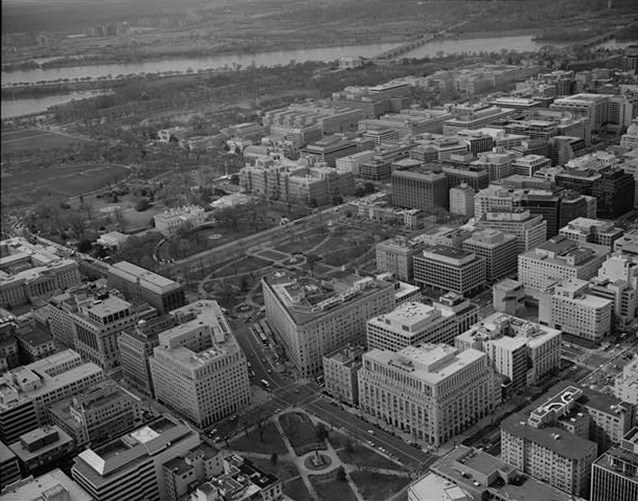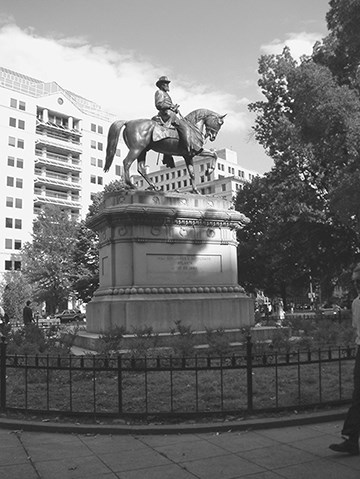Last updated: October 8, 2021
Article
McPherson Square Cultural Landscape

HABS, US Library of Congress
McPherson Square is a 1.66-acre park lying in the heart of the central business district in northwest Washington, DC. It occupies an entire city square surrounded by K Street to the north, I Street to the south, and 15th Street to the east and west.
The sculpture depicts General McPherson mounted on a horse and turning in the saddle to face west, surveying a field of battle. The 12-foot bronze statue stands on a 15-foot granite pedestal. Large deciduous trees line the boundaries of the park and are placed randomly along the major walks, emphasizing the spatial pattern. McPherson Square is heavily used by local residents, office workers, and tourists.

NPS (2004)
The only tree that actually stands in the center of a panel rather than near an edge is the huge red oak in the southern triangular panel; this tree probably dates from the late nineteenth century and was likely one of the first trees planted. A large gingko near the sidewalk in this triangle may also date from before 1920. In 1981, magnolias and crabapples were planted around the statue plaza. The primary vistas from McPherson Square are along the parallel walks that follow the line of Vermont Avenue through the park. Historically, there was a Chinese Elm tree located near the sidewalk. However, the tree is no longer present, and the circulation was slightly modified in 2010 to account for the removal of the tree.
Looking southwest along this axis provides a vista of the northeast corner of Lafayette Park, one block away. The bus shelter obstructs this vista. Looking northeast affords a vista of Thomas Circle, at the intersection of Vermont Avenue with 15th Street and Massachusetts Avenue. Also significant are the reciprocal views between McPherson Square and the surrounding mid-twentieth-century buildings.
The statue remains in its original location. The circulation system dating to 1930-31 is intact, with rehabilitation having been done in 2010. Spatial organization and land use have not changed greatly, except for increasing numbers of pedestrians. Vegetation retains medium integrity to the 1930-31 planting plan; though there have been removals and replacements of trees, both trees and lawns have kept essentially the same layout. The hedges that formerly surrounded the major grass panels have been removed, as have several trees added in the 1980s that partly blocked the vistas along the Vermont Avenue corridor. Most small-scale features date from the 1960s or later, with the exception of the concrete drinking fountain, which does not function.
Quick Facts
- Cultural Landscape Type: Designed
- National Register Significance Level: National
- National Register Significance Criteria: A,B,C
- Period of Significance: 1791; 1867-1933
